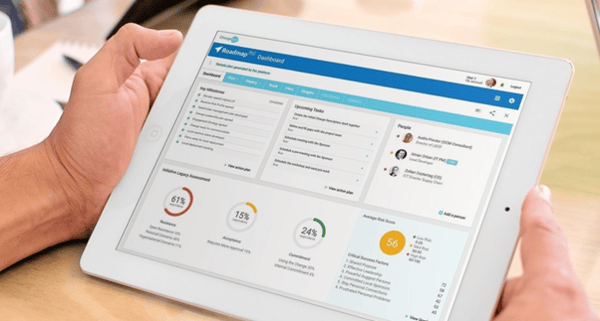-1.png?width=660&height=330&name=Untitled%20design%20(2)-1.png)
There seems very little room for doubt that there is a data-driven revolution taking place around business in general. In fact, a recent UN report observed that "... the volume data in the world is increasing exponentially. By some estimates 90% of that data has been created just in the last two years and is projected to increase by 40% annually".
And increasingly companies are using it to provide the competitive edge in everything from product research, to operations and the way they create and refine experiences for their customers. Everything from improving airline ETAs to improved and more personalized promotions at point of sale.
Take the example of MIT labs experiment to see if it was possible to forward predict the level of retail sales on Black Friday in the US, just after Thanksgiving. Traditionally they would have waited to assess the data on the level of spend, provided by the stores themselves – after the event. But in an innovative departure from this approach – instead they used data from individuals’ mobile phones to infer how many people were in the parking lots of the big retail outlets and married it up with average spend data to estimate retail sales – before they actually happened.
The potential upside in Change is huge
So big data is transforming not only the business landscape – but the way that we interact with companies in our everyday lives. But companies have been slow to apply a model of data driven change management based on change management analytics. And the potential upside is huge.
In this blog series, we are going to take a closer look at:
- Some of the key ways that using big data can transform the effectiveness of your change management approach
- How to use data to baseline your change initiatives
- Taking a data driven approach to selection, assessment and development of people in key change roles
- Creating powerful dashboards for your change management reporting
If you would like to be kept up to date as we publish new posts, you can subscribe for update on the top right-hand side of the page.
However, in this first post in the series we zero in on the 5 key ways that we believe leveraging big data can truly transform your change management approach and performance.
Data, data everywhere
Organizations are awash with data – and from a change management perspective that probably means several silos of assessment, risk and other change data spread out across teams, systems, shared drives and individual computers.
All highly valuable in its own right, but relatively useless unless you have the systems and processes and in place to capture and analyze it and democratize the use of data in the organization make operational, tactical and strategic (yet democratized) decisions based on the information.
In fact, as pointed out in a recent article, the implementation of big data in your organization – and your change management function is part of that - is a change project in its own right. And change management can help predict the success or failure of the initiative if done correctly in a data-driven way.
Moving change management from soft art to hard science
So, this move to making change management data more central to the planning, implementation and review of change. It’s about making shifting change management from a purely soft art to more of a hard science – in the same way that, for example, marketing has made the transition in recent years. Or at the very least it’s about using more hard science to complement and better inform the “smarts” and gut instinct that you have built up in your time as a highly successful change practitioner.
And in some ways, it’s a credibility issue too.
Very often change practitioners can be highly engaged – and successful - in enabling the smooth delivery of projects and programs. However, the absence of data on the “why” things were successful and how the model can be applied to emerging projects and programs, creates somewhat of a validity gap in organization.
Good, highly structured change management data plugs this gap and also firmly establishes and cements change management place as the highly valued service it deserves to be. Leading organizational change is also hard enough. Data-driven decision-making can significantly ease the pain and make your day to day life a whole lot easier.
5 key ways that change management data can transform your approach to change
One quick caveat before we dip into 5 key areas that we see data making a significant and measurable impact on the way you get change “done”.
In reality, you will never reach 100% commitment on your projects and initiatives, that’s not what we are saying. But what you can do – by taking the time to establish the analytical tools and tracking processes – is to baseline your change, using legacy data that helps you establish your capacity for change. And from there you can monitor and assess both known and emerging risks, to ensure you have the headline view that enables you to assess and pivot as need to release the business value in projects.
And, also, the dashboard driven approach that enables you communicate out on progress, obstacles, wins and challenges. All in a way that ensures you can get key stakeholders from top management down to front line managers onboard. And truly make change everyone’s business.
Here are the 5 key benefits we see from using change management data in our work with clients:
1. Get a real-time check on your change initiatives
By starting to use digital assessment and diagnostic tools you get a real time barometer on how change is being received across teams, functions and geos in your organization.

The speed with which you can do this using a digital change platform not only gives you a quick and accurate “temperature check” on how managers are faring at delivering key messages around change to employees – ensuring you have access to instantaneous data that enables you to pivot and react to things – but because you are also working digitally you have the capability to instantly share the data and insights with your wider team in a few short mouse clicks.
2. Using legacy data helps you improve change performance over time
Just like data matters, understanding legacy and the history of your change management successes matters hugely. Any organization that fails to take stock where it has been on change implementation is doomed to repeat the failure of the past from the outset, and unlikely to get where it needs to be. And the cost of failure is high:
- Costly for people: as poorly planned change is disruptive and over time can wear down their resilience
- Costly for leaders: poorly planned and executed change ultimately costs leaders their credibility
- Costly for organizations: poorly planned change can significantly affect organizational performance and competitiveness
However, organizations that capture and leverage legacy data about change can use it to better inform and improve change performance now and in the future. By learning from both good and bad experiences, there are clear insights for change leaders about:
- the likely results from new change projects if old practices are repeated
- strengths to be leveraged
- focus areas for greater success
We leverage this on a daily basis in our work with clients, for example, by using our Roadmap Pro digital change management platform to quickly review, adjust and redeploying plans and tactics that you know were successful to similar projects across the organization.
3. Structured use of data can help with selection and assessment of your team
By taking a structured and proactive approach to using change data in the selection and assessment of people for change roles you enhance the chances of success.
We use this type of approach in a number of ways:
- Change Agent Assessment – an integrated assessment which is available on our digital platform and which is specifically designed to aid the selection of the most suitable candidate to implement a change initiative. It can also be used to assess development needs for a change agent.
- Sponsor assessment – a dedicated assessment for change leaders which is specifically designed to provide them with guidance and feedback on key variables including behavior modelling, use or positive/negative enforcement, understanding people impact to change and focus on future state objectives.
More on these to follow in a subsequent blog as part of the series.
4. You can take a dashboard driven approach to change
That mirrors the approach that the rest of the organizations is taking in the way that they collect, analyze and report data and insight.

By taking a dashboard driven approach to change you allow sponsors and executives the information they need, in a structured and centralized way, that enables them to make decisions around:
- The volume of change that the organization can absorb
- Go/no go decisions
- Project and change prioritization
5. All of this makes leader engagement easier
If leaders are constantly interacting with your peers in sales, finance, marketing and ops who are reporting to them on increasingly sophisticated dashboards then it’s only natural that they are going to have a similar expectation of change management.
As a discipline, change management is far from short of data. In spreadsheets, on hard drives, shared drives and computer desktops. The key to making it valuable is centralizing it on a single platform and delivering it in a way that engages leaders and people in the task at hand.
It’s all about engagement. And by leveraging the power of big data you can ensure that everyone knows what’s working, what’s not and how – as a team – you are going to fix things.
That concludes our first post on this particular series on big data – and how it can transform your approach to change. Over the next few weeks we will be taking a look at the topic from a number of different angles including how you can use data to effectively baseline your changes, how you can build it into your selection and development processes and how to use it to create powerful dashboards for your change initiatives.





Leave a comment